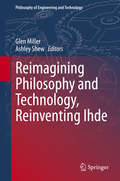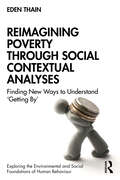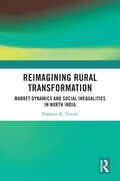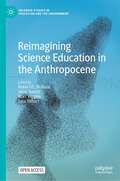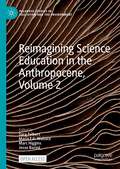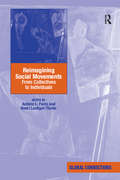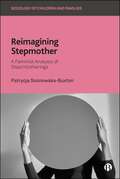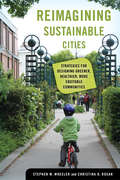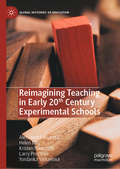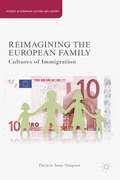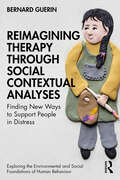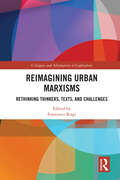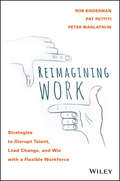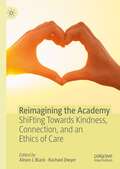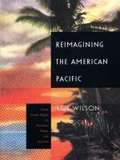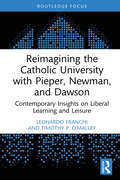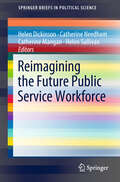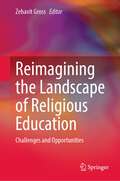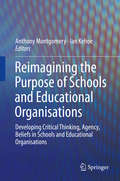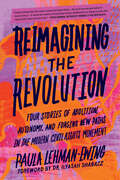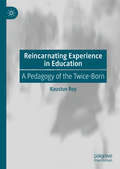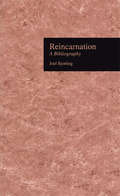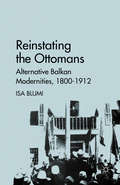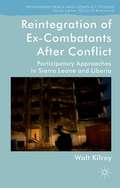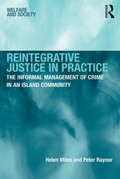- Table View
- List View
Reimagining Philosophy and Technology, Reinventing Ihde (Philosophy of Engineering and Technology #33)
by Ashley Shew Glen MillerThis volume includes eleven original essays that explore and expand on the work of Don Ihde, bookended by two chapters by Ihde himself. Ihde, the recipient of the first Society for Philosophy and Technology's Lifetime Achievement Award in 2017, is best known for his development of postphenomenology, a blend of pragmatism and phenomenology that incorporates insights into the ways technology mediates human perception and action.The book contains contributions from academics from Europe, North America, and Asia, which demonstrates the global impact of Ihde’s work. Essays in the book explore the relationship between Ihde's work and its origins in phenomenology (especially Husserl and Heidegger) and American pragmatism; integrate his philosophical work within the embodied experience of radical architecture and imagine the possibility of a future philosophy of technology after postphenomenology;develop central ideas of postphenomenology and expand the resources present in postphenomenology to ethics and politics; andextend the influence of Ihde's ideas to mobile media and engineering, and comprehensively assess the influence of his work in China. The book includes a reprint of the Introduction of Sense and Significance, one of Ihde's first books; "Hawk: Predatory Vision," a new chapter that blends his biographical experience with feminism, technoscience, and environmental observation; and an appendix that lists all of Ihde's books as well as secondary sources annotated by Ihde himself. Starting with an Editors' Introduction that offers an overview of the central ideas in Ihde's corpus and concluding with an index that facilitates research across the various chapters, this book is of interest to a diverse academic community that includes philosophers, STM scholars, anthropologists, historians, and sociologists.
Reimagining Poverty through Social Contextual Analyses: Finding New Ways to Understand ‘Getting By’ (Exploring the Environmental and Social Foundations of Human Behaviour)
by Eden ThainThis book is the first of its kind to apply social contextual analysis to the issue of poverty. It sets out detailed accounts of poverty based on original research and shows how understanding life contexts can give us a deeper understanding of the issue.The book highlights detailed life contexts from a project exploring the everyday experience of poverty, including what poverty is and what psychology has to say about poverty. It showcases work from an original study in Australia that uses on-the-ground participatory interview research, integrating this with international literature to provide a comprehensive analysis of poverty. The chapters explore the complexity, and often the simplistic reductions used in answering questions that try to define poverty, the psychological understanding of the phenomena, how individuals experience it, and the general opinion of the status-quo regarding poverty. However, most importantly the book tries to investigate why we have not solved poverty in modern, capitalist life, and sets out recommendations for research, practice, and policy in addressing issues of poverty.Showing the need for rigorous and on-the-ground approaches to addressing poverty and its many complications, the book will be highly relevant to students and researchers in the fields of social psychology, critical psychology, community psychology, social work, and social policy. It will also be relevant for anyone interested in the application of social psychological research techniques to the understanding and intervention of social issues, by showing pathways to better explore and understand human behaviour.
Reimagining Rural Transformation: Market Dynamics and Social Inequalities in North India
by Prashant K TrivediThis book examines the effects of the pattern of growing integration between the rural and urban economies in India. Drawing on in-depth surveys conducted in villages in north India, it examines the rural agricultural economy's transformation, productivity, technology deployment, and social relations over a period of seven years. The book focuses on the socially embedded nature of the dynamics of transformation, weaving analysis around the axis of land, caste, and gender. It also identifies policy gaps and recommends steps for a sustainable and inclusive rural transformation in the Global South.An important contribution to the study of India’s economic and social landscape, this book will be useful for scholars of agriculture, sociology, economics, political science, development studies, and South Asian studies. It will also be of interest to policymakers and journalists interested in rural development, migration, employment, agriculture, and demography.
Reimagining Science Education in the Anthropocene (Palgrave Studies in Education and the Environment)
by Jesse Bazzul Marc Higgins Maria F. G. Wallace Sara TolbertThis open access edited volume invites transdisciplinary scholars to re-vision science education in the era of the Anthropocene. The collection assembles the works of educators from many walks of life and areas of practice together to help reorient science education toward the problems and peculiarities associated with the geologic times many call the Anthropocene. It has become evident that science education—the way it is currently institutionalized in various forms of school science, government policy, classroom practice, educational research, and public/private research laboratories—is ill-equipped and ill-conceived to deal with the expansive and urgent contexts of the Anthropocene. Paying homage to myopic knowledge systems, rigid state education directives, and academic-professional communities intent on reproducing the same practices, knowledges, and relationships that have endangered our shared world and shared presents/presence is misdirected. This volume brings together diverse scholars to reimagine the field in times of precarity.
Reimagining Science Education in the Anthropocene, Volume 2 (Palgrave Studies in Education and the Environment)
by Jesse Bazzul Marc Higgins Maria F. G. Wallace Sara TolbertThis volume, a follow up to Reimagining Science Education in the Anthropocene (2021), continues a transdisciplinary conversation around reconceptualizing science education in the era of the Anthropocene. Drawing educators from many walks of life and areas of practice together in a creative work that helps reorient science education toward the problems and peculiarities associated with this contemporary geologic time. This work continues the mission of transforming the ways communities inherit science and technology education: its knowledges, practices, policies, and ways-of-living-with-Nature. Our understanding of the Anthropocene is necessarily open and pluralistic, as different beings on our planet experience this time of crisis in different ways. This second volume continues to nurture productive relationships between science education and fields such as science studies, environmental studies, philosophy, the natural sciences, Indigenous studies, and critical theory in order to provoke a science education that actively seeks to remake our shared ecological and social spaces in the coming decades and centuries. This is an open access book.
Reimagining Social Movements: From Collectives to Individuals (Global Connections)
by Henri Lustiger-ThalerThe social scientific study of social movements remains largely shaped by categories, concepts and debates that emerged in North Atlantic societies in the late 1960s and early 1970s, namely resource mobilization, framing, collective identity, and new social movements. It is now, however, increasingly clear that we are experiencing a profound period of social transformation associated with online interactivity, informationalization and globalization. Written by leading experts from around the world, the chapters in this book explore emerging forms of movement and action not only in terms of the industrialized countries of the North Atlantic, but recognizes the importance of globalizing forms of action and culture emerging from other continents and societies. This is the first book to bring together key authors exploring this transformation in terms of action, culture and movements. It not only engages with critical transformations in the nature of collective action, but also makes a significant contribution to the globalizing of sociology.
Reimagining Stepmother: A Feminist Analysis of Step(m)otherings (Sociology of Children and Families)
by Patrycja Sosnowska-BuxtonStepmothers often battle with a range of negative myths and stereotypes, with Cinderella’s wicked stepmother being the most infamous. Drawing on 20 in-depth interviews with British stepmothers, this book reimagines the expectations, practices and position of stepmothers through a feminist sociological lens. Combining firsthand accounts, including the author’s own experiences, the book reveals the complexities of stepfamily dynamics and how stepmothers navigate them. By examining the interplay between personal experiences and broader gendered, historical and social structures, the author offers a fresh perspective on contemporary stepmothers and stepfamilies.
Reimagining Sustainable Cities: Strategies for Designing Greener, Healthier, More Equitable Communities
by Stephen M. WheelerA cutting-edge, solutions-oriented analysis of how we can reimagine cities around the world to build sustainable futures. What would it take to make urban places greener, more affordable, more equitable, and healthier for everyone? In recent years, cities have stepped up efforts to address climate and sustainability crises. But progress has not been fast enough or gone deep enough. If communities are to thrive in the future, we need to quickly imagine and implement an entirely new approach to urban development: one that is centered on equity and rethinks social, political, and economic systems as well as urban designs. With attention to this need for structural change, Reimagining Sustainable Cities advocates for a community-informed model of racially, economically, and socially just cities and regions. The book aims to rethink urban sustainability for a new era. In Reimagining Sustainable Cities, Stephen M. Wheeler and Christina D. Rosan ask big-picture questions of interest to readers worldwide: How do we get to carbon neutrality? How do we adapt to a climate-changed world? How can we create affordable, inclusive, and equitable cities? While many books dwell on the analysis of problems, Reimagining Sustainable Cities prioritizes solutions-oriented thinking—surveying historical trends, providing examples of constructive action worldwide, and outlining alternative problem-solving strategies. Wheeler and Rosan use a social ecology lens and draw perspectives from multiple disciplines. Positive, readable, and constructive in tone, Reimagining Sustainable Cities identifies actions ranging from urban design to institutional restructuring that can bring about fundamental change and prepare us for the challenges ahead.
Reimagining Teaching in Early 20th Century Experimental Schools (Global Histories of Education)
by Larry Prochner Kristen Nawrotzki Helen May Yordanka Valkanova Alessandra Arce HaiThis book considers the diffusion and transfer of educational ideas through local and transcontinental networks within and across five socio-political spaces. The authors examine the social, political, and historical preconditions for the transfer of “new education” theory and practices in each period, place, and school, along with the networks of ideas and experts that supported this. The authors use historical methods to examine the schools and to pursue the story of the circulation of new ideas in education. In particular, chapters investigate how educational ideas develop within contexts, travel across boundaries, and are adapted in new contexts.
Reimagining The European Family
by Patricia Anne SimpsonRe-imagining the Family explores contemporary films and literature about the effects of legal and illegal immigration on the structure and the stories of the contemporary 'European' family, with a focus on Germany.
Reimagining Therapy through Social Contextual Analyses: Finding New Ways to Support People in Distress (Exploring the Environmental and Social Foundations of Human Behaviour)
by Bernard GuerinThis book attempts to ‘shake up’ the current complacency around therapy and ‘mental health’ behaviours by putting therapy fully into context using Social Contextual Analysis; showing how changes to our social, discursive, and societal environments, rather than changes to an individual’s ‘mind’, will reduce suffering from the ‘mental health’ behaviours. Guerin challenges many assumptions about both current therapy and psychology, and offers alternative approaches, synthesized from sociology, social anthropology, sociolinguistics, and elsewhere. The book provides a way of addressing the ‘mental health’ behaviours including actions, talking, thinking, and emotions, by taking people’s external life situations into account, and not relying on an imagined ‘internal source’. Guerin describes the broad contexts for current Western therapies, referring to social, discursive, cultural, societal, and economic contexts, and suggests that we need to research the components of therapies and stop treating therapies as units. He reframes different types of therapy away from their abstract jargons, offering an alternative approach grounded in our real social worlds, aligning with new thinking that challenges the traditional methods of therapy, and also providing a better framework for rethinking psychology itself. The book ultimately suggests more emphasis should be put on ‘mental health’ behaviours as arising from social issues including the modern contexts of extreme capitalism, excessive bureaucracy, weakened discursive communities, and changing forms of social relationships. Practical guidelines are provided for building the reimagined therapies into clinics and institutions where labelling and pathologizing the ‘mental health’ behaviours will no longer be needed. By putting ‘mental health’ behaviours and therapy into a naturalistic or ecological social sciences framework, this book will be practical and fascinating reading for professional therapists, counsellors, social workers, and mental health nurses, as well as academics interested in psychology and the social sciences more generally.
Reimagining Urban Marxisms: Rethinking Thinkers, Texts, and Challenges (Critiques and Alternatives to Capitalism)
by Francesco BiagiThis volume presents an interdisciplinary and international revaluation of urban Marxisms.Bringing together the main critical Marxist perspectives from around the world on contemporary urban studies, it engages with a range of issues connected to the “urban question,” such as urban sprawl, housing, and increasing rates of urbanization across the globe. With attention to the manner in which the three axes of class, gender, and race play a fundamental role in contemporary social phenomena, it interweaves different issues that are inextricably linked in matters of urban inequality. The book bridges a significant gap between urban studies and Marxists theories by reviving Marx and Engels’ ideas in the context of analyzing urban studies in the twenty-first century. The objective is to bring together diverse perspectives and directions of the ongoing debate on the “urban question.” Although there are multiple Marxisms and theoretical currents inspired by Marxism that seek to understand the urban and spatial transformations of today, there has been a lack of comprehensive scholarship that systematically brings them together to frame this debate. The goal is to unite the main critical Marxist perspectives on contemporary urban studies.Reimagining Urban Marxisms will therefore appeal to scholars across disciplines with interests in Marxist analyses of contemporary urban and spatial transformations, and the phenomenon of planetary urbanization.
Reimagining Work: Strategies to Disrupt Talent, Lead Change, and Win with a Flexible Workforce
by Rob Biederman Pat Petitti Peter MaglathlinThrive in the new economy by leading ahead of the next evolution Reimagining Work is the business leader's guide to surviving—and thriving—in the new on-demand economy. As the business and workplace environments evolve, traditional management strategies are becoming obsolete; the skilled workforce demands flexibility and more control over their work—things that the major corporations repeatedly fail to offer. Is it any wonder that the best and brightest talent is increasingly moving toward smaller companies with alternative management structures? Companies like Uber, Lyft, Handy, and Task Rabbit? These businesses have seen major success by attracting the right people—by giving them what they want. As the shift continues, businesses will need to change the way they recruit, develop, and train talent. This book shows you how to restructure and reconfigure your current strategy toward one that will help your business not just survive, but grow stronger in this new environment by offering what top talent demands. Niche spaces like transportation and general labor may have catalyzed the movement toward on-demand, but their influence is spreading and traditional businesses must adapt or die. This book shows you how to turn the shift into an asset for your company by leading through change for the better. Reconsider your current talent sourcing strategies Update your team development and training programs Build a flexible workforce that thrives in the "on-demand" economy Develop your business to succeed amidst the changing business paradigm Growth is more than just expansion; it's also maturation, adaptation, and evolution. Our economy is on the cusp of a seismic shift, and smart businesses will implement change early before the obsolete start falling behind. Reimagining Work gives you actionable guidance for staying ahead of the curve.
Reimagining the Academy: ShiFting Towards Kindness, Connection, and an Ethics of Care
by Rachael Dwyer Alison L BlackThis book explores the capacities and desires of academic women to reimagine and transform academic cultures. Embracing and championing feminist scholarship, the research presented by the authors in this collection holds space for a different way of being in academia and shifts the conversation toward a future that is hopeful, kind and inclusive. Through exploring lived experiences, building caring communities and enacting an ethics of care, the authors are reimagining the academy’s focus and purpose. The autoethnographic and arts-based research approaches employed throughout the book provide evocative conceptual content, which responds to the symbolic nature of transformation in the academy. This innovative volume will be of interest and value to feminist scholars, as well as those interested in disrupting and rejecting patriarchal academic structures.
Reimagining the American Pacific: From South Pacific to Bamboo Ridge and Beyond
by Rob WilsonIn this compelling critique Rob Wilson explores the creation of the "Pacific Rim" in the American imagination and how the concept has been variously adapted and resisted in Hawai'i, the Pacific Islands, New Zealand, and Australia. Reimagining the American Pacific ranges from the nineteenth century to the present and draws on theories of postmodernism, transnationality, and post-Marxist geography to contribute to the ongoing discussion of what constitutes "global" and "local." Wilson begins by tracing the arrival of American commerce and culture in the Pacific through missionary and imperial forces in the nineteenth century and the parallel development of Asia/Pacific as an idea. Using an impressive range of texts--from works by Herman Melville, James Michener, Maori and Western Samoan novelists, and Bamboo Ridge poets to Baywatch, films and musicals such as South Pacific and Blue Hawaii, and native Hawaiian shark god poetry--Wilson illustrates what it means for a space to be "regionalized." Claiming that such places become more open to transnational flows of information, labor, finance, media, and global commodities, he explains how they then become isolated, their borders simultaneously crossed and fixed. In the case of Hawai'i, Wilson argues that culturally innovative, risky forms of symbol making and a broader--more global--vision of local plight are needed to counterbalance the racism and increasing imbalance of cultural capital and goods in the emerging postplantation and tourist-centered economy. Reimagining the American Pacific leaves the reader with a new understanding of the complex interactions of global and local economies and cultures in a region that, since the 1970s, has been a leading trading partner of the United States. It is an engaging and provocative contribution to the fields of Asian and American studies, as well as those of cultural studies and theory, literary criticism, and popular culture.
Reimagining the Catholic University with Pieper, Newman, and Dawson: Contemporary Insights on Liberal Learning and Leisure
by Leonardo Franchi Timothy P. O’MalleyThis compact volume argues compellingly for a classical understanding of leisure within the context of Catholic universities and explores how a critically nuanced reading of the work of philosopher Josef Pieper, theologian St John Henry Newman, and cultural historian Christopher Dawson can reframe debates over the nature of Catholic universities.Chapters facilitate a refreshed understanding of how leisure, as proposed by Pieper, potentially promotes a liberal, humanistic vision of the Catholic university as a site of integral human development. In so doing, the book fundamentally questions and re-evaluates the purpose of a university, reframing the idea of what it constitutes both in theory and practice. This approach enables institutions to remain open to diverse intellectual traditions while confidently drawing upon their own rich heritage to create genuinely hospitable academic communities. Ultimately, the book offers a vision for reforming Catholic higher education that challenges the increasingly utilitarian and market-driven models dominating contemporary university life.Grounded in solid historical foundations while offering innovative thinking around Catholic university reform, the book will be of interest to scholars, researchers and postgraduate students with an interest in Catholicism and the philosophy of education. Those more broadly interested in exploring the intersection between education, philosophy, and religion will also find the volume of use.
Reimagining the Future Public Service Workforce (SpringerBriefs in Political Science)
by Helen Dickinson Catherine Mangan Helen Sullivan Catherine NeedhamThis book investigates the professional needs and training requirements of an ever-changing public service workforce in Australia and the United Kingdom. It explores the nature of future roles, the types of skills and competencies that will be required and how organisations might recruit, train and develop public servants for these roles. Leading international research - practitioners make recommendations for how local organisations can equip future public servants with the skills and professional capacities for these shifting professional demands, and the skillsets they will require. Drawing on ideas that have been developed in the Australian and UK context, the book delves into the major themes involved in re-imagining the public service workforce and the various forms of capacities and capabilities that this entails. It then explores delivery of this future vision, and its implications in terms of development, recruitment and strategy.
Reimagining the Landscape of Religious Education: Challenges and Opportunities
by Zehavit GrossThis book brings together new thinking and research on religious education’s complex and evolving role in the multicultural, diverse postmodern era. It facilitates new realism and understanding of the current situation from empirical and reflective accounts relating to a variety of countries and political contexts, as well as providing innovative methodological approaches to the study of education and religion.In different contexts around the world, at different levels of education, and from different theoretical lenses, religious education occupies a contested space. The ongoing, changing nature of the world due to increasing secularization, rapid technological change, mass immigration, globalization processes, conflict and challenging security issues, from inter to intra state levels, and with shifting geopolitical power balances, generates the need to reconceptualize where religious education is positioned. It claims that religious education on its own can be an agent of moral, social and spiritual transformation are disputed. There is significant controversy about whether special religious education, that is in-faith education, still has a role within the post-modern world.
Reimagining the Purpose of Schools and Educational Organisations
by Anthony Montgomery Ian KehoeThis book features a diverse set of perspectives all focused towards questioning the role schools actually play in society and, more importantly, the role they could potentially play. Containing papers presented at the 1st International Conference on Reimagining Schooling which took place in Thessaloniki, Greece, June 2013, bringing together international and multi-disciplinary perspectives on the future of education and schools. Combines diverse specialties analyzing schools as organizations and questions the purpose of schools. The book explores the current purpose of schooling and debates what roles and values young people currently learn from schooling. It examines such issues as the impact of Neoliberalism, the pursuit of the socially just school, and imagining contemporary schools beyond their consumerist mentality. Tackling development in the growing economic and social crisis in Europe, and offering transformative analysis of the psychology and decision-making involved for innovating teaching, learning, socio-economic and policy contexts. In addition, the book shows different ways young people can be creatively involved in reimagining schooling. It also details both innovative and radical ideas that currently exist about school transformation such as building learning partnerships for all and creating synergies across formal and informal settings of learning. Raising important questions for the future of the relationship between teacher and pupil and positive and pro-active behavior. There is a growing realization that schools fail to accommodate diverse types of learning and that their purpose is not simply about education. Featuring academics and practitioners from many different disciplines, this book boldly questions the values that currently permeate school walls and suggests ways that schooling itself can be made better.
Reimagining the Revolution: Four Stories of Abolition, Autonomy, and Forging New Paths in the Modern Civil Rights Movement
by Paula Lehman-EwingThese are the architects of the modern civil rights movement: 4 profiles of revolutionary groups making change beyond protestA radically different approach to sustaining social justice movements—4 strategies for abolition and liberation from the new architects of the modern civil rights movementMany of us think, I don&’t support the police. But what should take their place? Or: Prisons don&’t keep us safe. But what new systems could?A lot of books about racial justice ask us how we got here, but Reimagining the Revolution is different: award-winning journalist and activist Paula Lehman-Ewing presents an inside-access look at the activists redefining where we go from here. Readers will hear from:Ivan Kilgore, an incarcerated activist who founded the 501c3 nonprofit United Black Family Scholarship Foundation from behind prison wallsCritical Resistance, one of the oldest grassroots organizations in the nation working to dismantle the prison-industrial complexThe co-founders of Greenwood, a Black-owned financial technology institution designed specifically for Black and Latino people and businesses: Michael Render, aka Killer Mike, Amb. Andrew Young and Ryan GloverIncarcerated activist Heshima Denham on his grassroots efforts to build a society for Black and Brown people independent of the state The Movement for Black Lives, the Alliance for Safety and Justice, BYP 100, and 8toAbolitionIncarcerated and formerly incarcerated artists using art to heal from trauma, connect with other incarcerated people, and amplify abolitionist changeLehman-Ewing frames each profile within two fundamental truths: The current system—built and sustained by oppression, extraction, and inequity by design—cannot be reformed. And, knowing this, we need abolition; we need creative solutions designed by the people most impacted by the systems they fight to change. Reimagining the Revolution is a call to action for each of us: if we can access the tools we have, we can dream bigger, think outside the box, and follow the paths laid out by change-making activists toward nothing short of revolution.
Reincarnating Experience in Education: A Pedagogy of the Twice-Born
by Kaustuv RoyThis book presents authentic educational experience as the actualization of a potential within a phenomenological field whose axes consist of the somatic, the psychic, and the symbolic, thereby rejecting the one-dimensionality of contemporary education that is primarily mind-oriented. The author insists on the nature of experiencing as coming to be in a living tension between the intuition and the intellect, or the inner and the outer, and calls this a pedagogy of the twice-born. Within this pedagogy, the truly educated must be born twice: in the first instance, involuntarily thrust into a commonsensical world, and in the second, taking a deliberate step toward a qualitative principle. The latter gives us ontological hope or a sense of autonomy and self-sufficiency.
Reincarnation: A Bibliography (Sects and Cults in America #Vol. 18)
by Joel BjorlingFirst Published in 1996. Routledge is an imprint of Taylor & Francis, an informa company.
Reinstating the Ottomans
by Isa BlumiThis book focuses on the western Balkans in the period 1820-1912, in particular on the peoples and social groups that the later national history would claim to have been Albanians, providing a revisionist exploration of national identity prior to the establishment of the nation-state.
Reintegration of Ex-Combatants After Conflict
by Walt KilroyReintegration programmes for ex-combatants are supposed to support the wider peace process. This study looks at the way they were carried out in Sierra Leone and Liberia and assesses the degree to which they were conducted in a participatory way. To a large extent, ex-combatants felt that they had received unreliable information and had been afforded little input in the process. Others, whose experience had been more participatory, were faring better in terms of work, economic situation andcommunity relations. Reintegration of Ex-Combatants After Conflict is based on detailed interviews with a wide range of stakeholders, and on a survey and focus group discussions with ex-combatants. Their voices are clearly heard, in both the qualitative and quantitative data. Kilroy explores the important implications for the effect of reintegration programmes on the wider peacebuilding project. Social capital, which affects the peace process, is also highlighted, as the extent to which this can be created or undermined depends on the way the programmes were conducted. Kilroy's insightful study will appeal to all those with an interest in conflict resolution, post-war recovery, and development.
Reintegrative Justice in Practice: The Informal Management of Crime in an Island Community (Welfare And Society Ser.)
by Peter Raynor Helen MilesRecent years have seen the development of a growing international literature on restorative justice, community justice and reintegrative alternatives to formal criminal justice processes. This literature is stronger on theory and advocacy than on detailed evaluative studies. It often relies for its practical examples on the presumed historical practices of the indigenous peoples of colonised territories, or on attempts to revive or promote modified versions of these in a modern context, which has led to debates about how far modern communities can provide a viable setting for such initiatives. This book provides a unique study of the practice of traditional reintegrative community justice in a European society: the Parish Hall Enquiry (PHE) in the Channel Island of Jersey. This is an ancient institution, based on an informal hearing and discussion of a reported offence with the alleged offender and other interested parties, carried out by centeniers (honorary police officers elected to one of Jersey's twelve parishes). It is still in regular use as an integral part of a modern criminal justice system, and it usually aims to resolve offences without recourse to formal prosecution in court. Helen Miles and Peter Raynor's research, arising from direct observation, contributes to the literature on 'what works' in resolving conflicts and influencing offenders, and their detailed case studies of how problems are addressed gives a 'hands on' flavour of the process. The authors also document the aspects of community life in Jersey that facilitate or hinder the continuation of the PHEs, drawing out the implications of these findings for wider debates about the necessary and sufficient social conditions for reintegrative justice to succeed.
